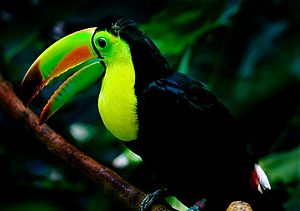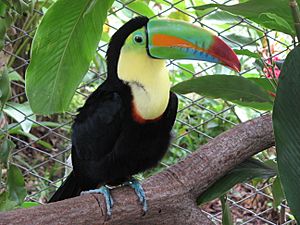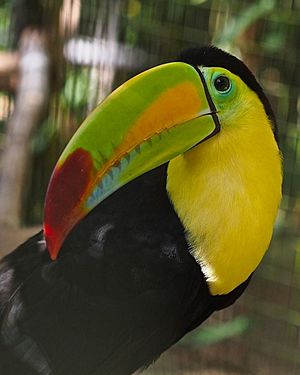Keel-billed Toucan facts for kids
Quick facts for kids Keel-billed Toucan |
|
|---|---|
 |
|
| Conservation status | |
| Scientific classification | |
| Kingdom: | |
| Phylum: | |
| Class: | |
| Order: | |
| Family: | |
| Genus: |
Ramphastos
|
| Species: |
R. sulfuratus
|
| Binomial name | |
| Ramphastos sulfuratus Lesson, 1830
|
|
Get ready to learn about one of the most colorful birds in the world: the Keel-billed Toucan! This amazing bird is also called the Sulfur-breasted Toucan or Rainbow-billed Toucan. It's a type of toucan found in Latin America. Did you know it's the national bird of Belize?
You can find these toucans living in warm, wet rainforests. They live from southern Mexico all the way down to Venezuela and Colombia. Keel-billed Toucans are very social birds. They usually travel in small groups of 6 to 12 birds. They aren't great at flying long distances. Instead, they mostly hop from tree to tree.
Contents
About the Keel-billed Toucan

The Keel-billed Toucan is a medium-sized bird. It measures about 17 to 22 inches (42–55 cm) long, including its bill. Its huge, colorful bill is about 5 to 6 inches (12–15 cm) long. That's about one-third of the bird's total length!
Even though the bill looks big and heavy, it's actually very light. It's made of a spongy, hollow bone. This bone is covered in a tough, light protein called keratin. Keratin is the same material that makes up your fingernails.
What Keel-billed Toucans Look Like
Most of the Keel-billed Toucan's feathers are black. They have a bright yellow neck and chest. Their feet are blue, and they have red feathers at the tip of their tail. The bill itself is mostly green with orange sides and a red tip.
These toucans replace their feathers once a year. This process is called molting. Keel-billed toucans have special feet. Two of their toes point forward, and two point backward. This helps them grip tree branches very well. It also helps them hop easily from one branch to another.
What Keel-billed Toucans Eat
Keel-billed Toucans love to eat fruit. They eat many different kinds of fruit found in the rainforest. But they also eat other things. Sometimes, they will eat insects, eggs, or even small reptiles.
When a toucan eats fruit, it uses its large bill to break the fruit apart. Then, it tosses its head back. This helps it swallow the fruit whole.
Life Cycle and Reproduction
Female Keel-billed Toucans lay 1 to 4 white eggs. They usually lay them inside a natural hole in a tree. Sometimes, they use a tree cavity that another animal has already made. Both the male and female toucan help care for the eggs. They take turns sitting on them to keep them warm. This is called incubating.
The eggs hatch after about 15 to 20 days. When the chicks are born, they don't have any feathers. Their eyes are also closed for about three weeks. Both parents work together to feed the baby toucans. The chicks stay in their nest for about eight to nine weeks. During this time, their colorful bills grow and develop fully.
Images for kids
-
At London Zoo
-
At Parque Municipal Summit, Panama
-
At Zoo Miami
See also
 In Spanish: Tucán piquiverde para niños
In Spanish: Tucán piquiverde para niños










